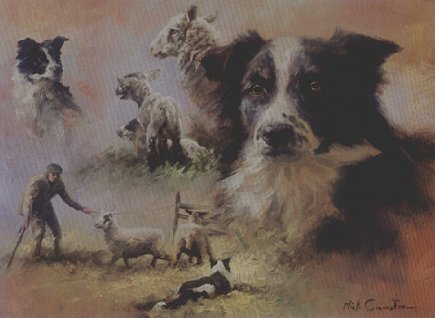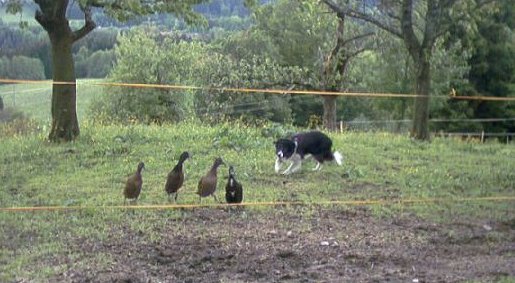

"Every dog and handler has peak performance potential - you just need to know where they are coming from and meet them there"
Vergil Holland
Herding is an activity that can provide you and your dog with many hours of useful work and enjoyment. You may be considered training a herding dog for farm or ranch work, or as a way to enjoy working as an activity for which your dog was originally bred. For those interested in competitions, there are organized Herding Trials.
You cannot force a dog to herd, the dog must have some degree of herding instinct in order to provide the interest necessary to work stock. Possession of instinct does not guarantee talent or ability in herding; but some lack of talent or ability can be offset through training and obedience.
Border Collies are gathering dogs that show eye and that, as a breed, usually show a lot of natural ability with stock.
Herding Terms
Balance
Balance is the basis for the dog`s ability to move the stock, regardless of the type of instinct that is present. This is the most important concept for the beginning handler to understand. Balance is based on movement by the sheep and the dog`s reaction to this movement, so that the dog is placing himself properly in relation to the sheep and handler. From the dog`s viewpoint, the "proper place" is the position that best prevents the escape of the sheep from the handler. The dog`s instinctual goal is to "establish balance" or " reach a balance point" that results in stopping all movements of the stock.
Outrun
the path of the dog when he leaves the handler and goes opposite side of stock in preperation for bringing them to the handler. The direction of the outrun may be off either the right or the left hand of the handler. Usually the outrun is a semicircular or pear-shaped path. The path of the outrun should keep the dog far enough from the sheep to prevent disturbing them and to ensure that the dog gathers individual stock that may be scattered over a fairly large area of the field.
Lift
the moment of initial contact between the dog and the stock, during which the dog begins the movement of the stock directly toward the handler.
Fetch
the path of movement of the stock to the handler, immediately following the lift. Usually the fetch should be a straight line, and the stock should be moving slowly or at a moderate or controlled rate of speed.
Wear or Wearing
refers to movement of the stock with the handler in the lead and the dog following behind the stock, holding the stock to the handler, in small circles, large circles or straight lines. Early in training you may be walking backward in order to keep an eye on the dog and direct him, as necesarry. Later, you may be walking with your back to the dog and sheep, occasionally looking over your shoulder in order to keep an eye on the stock and the dog.
Drive or Driving
refers to movement of stock away from the handler. The dog will be at the rear of the stock, pushing the stock ahead. The relative positions of the handler and dog may change according to the stage of training and reactions of the stock.
Pen or Penning
refers to movement of the stock into a pen or holding area. In trial situations there may be specific rules about the positions and actions of the handler and dog to accomplish this.
Shedding or Splitting
refers to seperating one(shedding) or more(splitting) head of stock from the rest. Traditionally this skill was necessary in order to treat an ill or injured individual or to seperate a selected individual or group for marked or slaughter. Herding Trials set specific rules about the area in wich the shed or split takes place, how it should be accomplished and acceptable actions by the handler and/or dog.
Grip or Gripping
refers to the dog biting or nipping at the stock. In farm work, this action may be necessary to move stubborn stock; at trials this action may be penalized or result in elimination of the dog from competition, if it is deemed inappropriate or unnecessary for a certain situation.
Behavior of Cattle
Cattle have more of a tendency to spread out than sheep. Once they are used to being worked, cattle will move as easily as, ore more easily than sheep. But some cattle may fight the dog more than sheep will, and they may not give up as easily. Be aware that your dog will likely take some bumps from cattle. Avoid letting your dog get caught in corners where he cannot escape. If caught in a corner by a wise old cow, your dog may get hurt or even killed.
Behavior of Ducks
Ducks tend to flock or stay in a group when being worked. Sometimes a wise old duck that is used to being worked will learn to split off every chance she gets. Another trick that ducks may learn is to stick their heads through woven wire fencing in order to resist being moved. Ducks do not tend to become as handler-oriented as sheep and, although they will group, do not tend to come to and stay with the handler like sheep. Also, they are more difficult to hold still in an area for practising outruns or fence-line pickups.
Behavior of Turkeys
Turkeys are known to panic at the drop of a hat! They may run into a corner and pile up, and, in extreme cases, suffocate. A quiet, well-trained dog may be able to work turkeys and cause even less panic than a human being.
Behavior of Chickens
Chicken can be a lot of fun to work. They move eaysily and are fast, but may flock as well as ducks.
Herding Commands
"Lie Down"
used as a stop command, to drop the dog in a prone position. This command may be replaced in later stages of training by "There", "Stand","Stay" or "Stand Stay" in order to have the dog stop on her feet in a standing position.
"Stay"
tells the dog not to move from the stopped position until a countercommand is given
"Walk In", "Walk Up" "Go In"
used to move the dog straight toward the stock. Variations of this command may be used to slow down or speed up the dog`s approach to the stock
"That`ll Do", "That will do"
used to releas the dog from whatever phase of work she is in and call her off the stock This command usually means that the dog should come to the handler and remain in the area to be available to work the stock again at any time "That`ll Do, Here" will call the dog off the stock and to you
"Come Bye" or "Go Bye"
used to direct the dog to swing in a clockwise direction around the stock, this clockwise movement is also referred to as being "off the left hand" of the handler
"Away to Me" or "Way to Me"
used to direct the dog to swing in a counterclockwise direction around the stock, this counterclockwise movement is also referred to as being "off the right hand" of the handler
"Steady", "Take Time" or " "Time"
used to tell the dog to approach the stock or move around the stock more slowly, this is particularly useful when the stock or circumstances are producing anxiety in the dog. I prefer to use "Steady" instead of "Take Time" because it has more methodical and calming sound, rather than an anxious tone
"Look Back"
used when the handler wants the dog to go farther from the handler in order to gather additional sheep that the dog may or may not be able to see, this command may be used with left and right directions to place the dog anywhere the handlers desires, for example, "Look Back, Come Bye"
"Go Back"
used when the dog is reasonably close to the handler, directs the dog to go in a direction straight away from the handler. This is used to relieve pressure when the dog is working relatively close to the stock, such as during penning or shedding
The above commands are all used as ordinary conversation or request of the dog, and are not to be used as reprimants(except in cases of severe disobedience). Terms that are mostly used as reprimands - "Get Out", "Out" or "Get Out of that" - tell the dog to stay off the sheep or move farther away from the stock, and to work at a greater distance from the stock
source: `Herding Dogs´ Vergil S. Holland - WONDERFUL BOOK !
